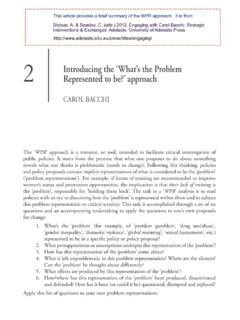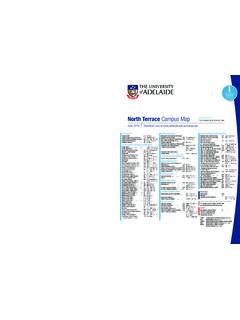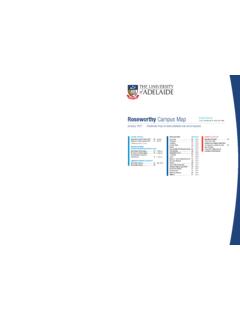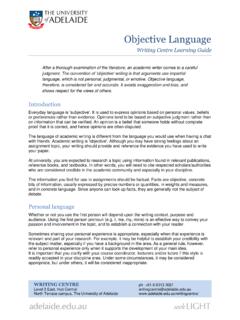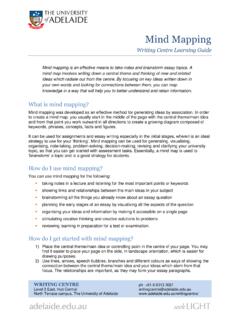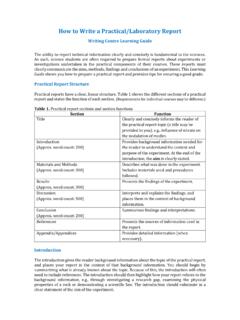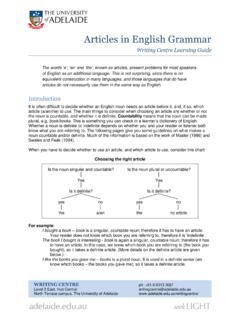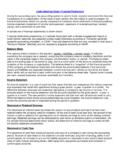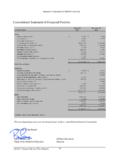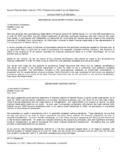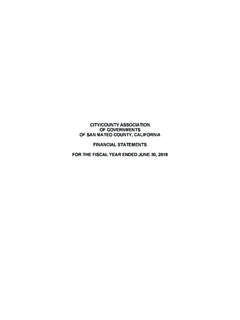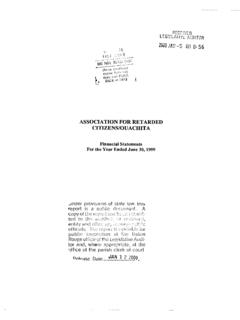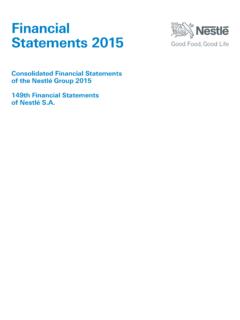Transcription of Veterinary Introduction to Business and Enterprise ...
1 Veterinary Introduction to Business and Enterprise financial Statements Explained The University of Adelaide 2 VIBE Learning Guide financial Statements Explained Table of Contents Introduction .. 2 Statement of financial position (balance sheet) .. 3 Assets .. 4 Liabilities .. 5 Owner s equity .. 6 Income statement (profit and loss statement) .. 7 Profit .. 7 Revenue and expenses .. 8 References and acknowledgements .. 8 Authors .. 8 With the exception of the Commonwealth Coat of Arms, and where otherwise noted, all material presented in this document is provided under Creative Commons Attribution-ShareAlike Unported License Introduction Veterinarians are not accountants, however there is a need for veterinarians to understand management accounting.
2 Management accounting is the provision of financial and non- financial information to Business managers for the purpose of decision-making. The most common forms of information for decision-making are financial statements. Under international accounting standards all businesses, including not-for-profit businesses, need to have at least two general purpose financial statements. Depending on the country and the legal entity of the Business several other financial statements may be required, however these are not covered in this learning guide. The two financial statements that the veterinarian needs to be familiar with are: statement of financial position (previously termed the balance sheet) income statement (previously termed the profit and loss statement) A brief summary of the components of each of these financial statements and examples from the case studies follows.
3 The University of Adelaide 3 Statement of financial position (balance sheet) The statement of financial position is a statement of assets, liabilities and owners equity as at a specific date. It is also called a balance sheet or statement of assets and liabilities. The statement of financial position for a Business shows: what the Business owns (assets) how it is financed (debt), and how much equity the owners have in the Business . The statement of financial position is based on the fundamental accounting equation: asset(s) = liabilities + owners equity. Consider your house (or your future house). It is an asset owned by you and financed partly by debt (your mortgage) and partly by your equity.
4 Assume that the house is worth $350,000 and you have a mortgage of $180,000. Your balance sheet for the house would be: asset(s)($350,000) = liabilities ($180,000) + owners equity ($170,000). The mix of debt and equity that we use to finance our assets is called leverage, or gearing. For an example of a statement of financial position (balance sheet) please see Table 1 below. Table 1. Summarised statement of financial position for Lamone and Yackaville Veterinary Practice 30th June 2013 Summary statement of financial position (balance sheet) Lamone and Yackaville Veterinary Practice 30th June 2013 Current assets Cash and receivables $115,236 $234,229 $552,178 Inventory $112,085 Prepayments $6,908 Non-current assets Fixed Assets $332,949 $317,949 Accumulated depreciation -$50,000 Intangible assets $35,000 Total assets Current liabilities Accounts payable to trade creditors $95,057 $125,321 $366,339 Superannuation, PAYG, and Leave provisions $25,264 GST NET payable $5,000 Non-current liabilities Loans equipment, trailer, motor vehicles $241,018 $241,018 Total liabilities Contributed capital $150,000 Retained earnings after drawings and current year earnings $35,838 Total owner equity $185.
5 839 Total liabilities and owners equity $552,178 As stated above, the statement financial position is based on the fundamental accounting equation: asset(s) = liabilities + owners equity. The University of Adelaide 4 More information about the components of the financial statement follows. Assets Assets are resources owned or controlled by a Business that are expected to have current or future economic benefit. They are obtained or controlled by a Business as a result of past transactions or events. The essential characteristics of an asset are: a probable future benefit exists involving capacity to contribute directly or indirectly to future net cash inflows; the Business can obtain benefit and control access of others to the benefit; the transaction or event that gave rise to the Business s claim to, or control of, the benefit has already occurred.
6 Assets are often split into two sub classifications: current assets non-current assets. Current assets are those assets to be converted into cash or used within the next accounting period, or 12 months. These assets include cash, inventory, accounts receivables (amounts owing from customers or debtors) and short term investments. Non-current assets are expected to remain in use for more than 12 months. These assets include equipment, land, buildings and motor vehicles. Current and non-current assets can be monetary or non-monetary in nature. Monetary assets are in cash terms or are claims to cash. These include cash at the bank or held by the Business , accounts receivable and short or long term investments which are claims to cash.
7 Non-monetary assets are physical assets such as inventories, furniture, plant and equipment. These assets pose a valuation problem because the original dollar value is attributed to assets when preparing financial statements. Most physical assets wear out and/or decline in value over time. A process of depreciation to allocate the decline in value of the asset over its useful service life in a systematic and rational manner is shown in a subsequent line as accumulated depreciation. There are also intangible non-current assets such as copyrights, patents and goodwill. To illustrate these definitions of assets, consider the following in Table 2 below: The University of Adelaide 5 Table 2.
8 Examples of assets and non-assets, and current or non-current assets Asset or not? Information Asset or not? Yes or No People Our greatest asset is our people . Are people assets of a Business ? People can be considered assets. However, a Business cannot always obtain the benefit from people involved with the Business . For example, consider the contracts of professional sports people. A club may be able to stop a prized player from playing for the opposition, but they cannot force the player to play for them at the best of his or her ability. Accordingly, people are not included as Business assets. No Car purchased outright Yes, non-current asset Car purchased with a loan Yes, non-current asset Car purchased with a four year lease Is leased equipment an asset?
9 Interestingly, if we lease an asset as an alternative to buying it, accounting standards see the lease as a financing arrangement and an asset recognised as lease rights . As such, Business rights over leased items are assets. Note, there is also the liability of lease obligations. Yes, non-current assets Lease of Plant & Equipment (initial purchase, not wear and tear replacement of low value items) Drugs Is inventory an asset? Yes, current assets Liabilities Liabilities are the economic obligations of an Enterprise and represent the obligations of a Business to transfer assets or provide services in the future as a result of past transactions or events. Typically, liabilities are amounts owed to creditors, employees, government and others.
10 A liability may also include an obligation to undertake a service. For example, an annual magazine subscription paid in advance creates a liability to the publisher to post issues to the customer for the next 12 months. Similarly, a Veterinary practice with annual wellness programs paid in advance would account for these as a liability to provide services to pet owner customers for the next 12 months. The essential characteristics of liabilities are: the duty to honour the future transfer or use of assets at a specified or determinable date, on occurrence of a specified event, or on demand; the Business has little or no discretion to avoid the future sacrifice; the transaction, or other event, obligating the Business has already happened.
